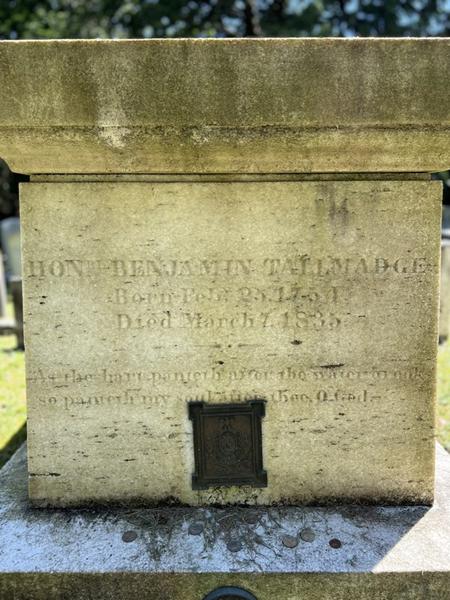Benjamin TALMAGE/TALLMAGE/TALLMADGE
SAR Patriot #:
P-335916
The following information was assembled from numerous sources and cannot be used directly as proof of Qualifying Service or Lineage.
It is considered a research aid and is intended to assist in locating sources that can be used as proof.
State of Service: CT
Qualifying Service: Major
DAR #: A112617
Birth: 25 Feb 1754 Brookhave / Suffolk / NY
Death: 07 Mar 1835 Litchfield / Litchfield / CT
Qualifying Service Description:
- June 1776, served as Adjutant of Chester’s Connecticut Regiment
- October 1776, Brigade Major to General Wadsworth
- December 1776, Captain of a company of the 2nd Continental Dragoons
- 1777, promoted to Major
- Shortly after the end of the War, in 1783, he was commissioned a Brevet Lieutenant-Colonel
Additional References:
- Rev War Pension file S46412
- Heitman, Francis B.Historical Register of Officers of the Continental Army During the War of the Revolution, 1775-1873, Washington DC: Rare Book Shop Publishing Company, 1914, pg 531-532
Spouse: (1) Mary Floyd; (2) Maria Hallet
Children: Henry Floyd; Frederick Augustus; Maria Jones;
Members Who Share This Ancestor
| Date Approved | Society | ACN | SAR Member Info | Lineage via Child | View Application Detail | |
|---|---|---|---|---|---|---|
| 2015-11-19 | WI | 66403 | Bruce Alan Graham (195247) | XX | ||
| 2016-02-11 | WI | 67995 | William Tallmadge Austin (195619) | Henry | ||
| 2021-09-03 | WI | 95968 | Howard Christopher Austin (195620) | Henry |
Burial:
Location:
Litchfield / Litchfield / CT / USA
Find A Grave Cemetery #:
Marker Type:
SAR
SAR Grave Dedication Date:
04 Jul 2017
Comments:
- Large raised tomb that appears to be contemporary with the Patriot's death.
- Multiple lugs/markers
- Photos used with permission of Compatriot Mitchell Anderson, 229001, KYSSAR
Directions to Cemetery / Gravesite:
Cemetery is located east of the center of Litchfield and is bounded by East Street and Torrington Road

